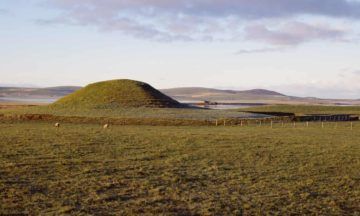Alice Albinia in The Guardian:
 Throughout history, the idea of islands where women rule has been part mythological wish fulfilment, part male fantasy – and part cultural-geographical reality. In 2017 I moved to Orkney, an archipelago still dominated, as all of Britain once was, by its monumental neolithic architecture. Early one spring morning I visited the chambered cairn of Maeshowe, which is older than Stonehenge and much more complex in construction. Originally a circle of standing stones, around 2800BC it was encased in huge slabs of rock, making a domed chamber aligned to the setting winter solstice sun. Five thousand years later, on any clear evening a few weeks either side of solstice, as the sun goes down behind the hill of a nearby island, it hits the top of a standing stone, and is channelled into Maeshowe in a burst of golden light. It is a sacred moment in Britain’s year: when nature and culture collide, exploding out of winter’s darkness in a dramatic symbol of warmth and hope.
Throughout history, the idea of islands where women rule has been part mythological wish fulfilment, part male fantasy – and part cultural-geographical reality. In 2017 I moved to Orkney, an archipelago still dominated, as all of Britain once was, by its monumental neolithic architecture. Early one spring morning I visited the chambered cairn of Maeshowe, which is older than Stonehenge and much more complex in construction. Originally a circle of standing stones, around 2800BC it was encased in huge slabs of rock, making a domed chamber aligned to the setting winter solstice sun. Five thousand years later, on any clear evening a few weeks either side of solstice, as the sun goes down behind the hill of a nearby island, it hits the top of a standing stone, and is channelled into Maeshowe in a burst of golden light. It is a sacred moment in Britain’s year: when nature and culture collide, exploding out of winter’s darkness in a dramatic symbol of warmth and hope.
We were there to experiment with neolithic acoustics. Kristin Linklater, an Orcadian voice coach, crawled down Maeshowe’s entrance passage first, followed by me and my baby daughter, an archaeologist or two, musicians and students. Inside the central chamber, we stood up and began to sing. Kristin and I had already discussed our fascination with Maeshowe’s shape, which, with its green turf covering, looks like a giant grassy breast or pregnant womb. Together, we had enjoyed deploring the fact that the female symbolism of this monument receives little if any mention in academic literature, let alone tourist guidebooks. Yet it is just as likely that structures such as Maeshowe were designed to honour the female body as a safehouse of human potency in the world, as they were to serve a male elite priesthood.
More here.
